Post-war use of German 37 mm automatic anti-aircraft guns
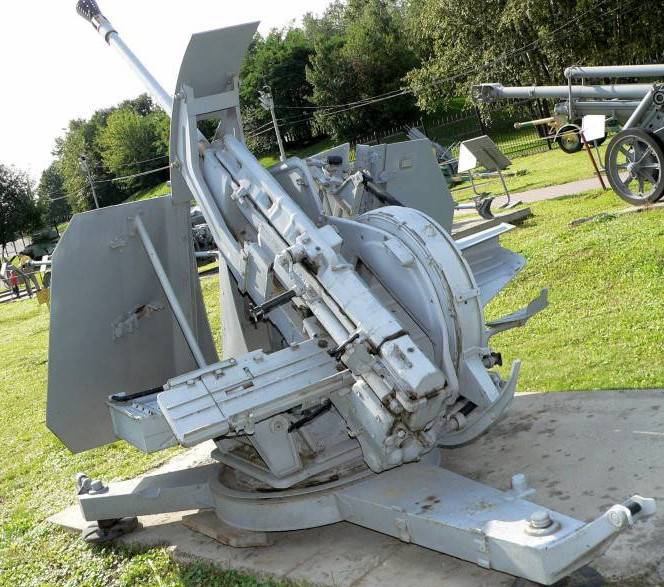
Of all the countries that participated in World War II, it was the Third Reich that had the best anti-aircraft artillery. This fully applied to both the characteristics of anti-aircraft guns and the saturation of the troops with them. At the final stage of hostilities, the Germans were largely able to compensate for the loss of air supremacy and the weakness of their own fighter force. aviation growth in the power of anti-aircraft artillery. 37-mm anti-aircraft guns played an important role in the air defense of the Wehrmacht and Kriegsmarine. And after the surrender of Nazi Germany, well-made 37-mm captured anti-aircraft guns were in service in a number of states.
37 mm anti-aircraft guns designed for use on land
The German armed forces entered World War II armed with 20-mm and 37-mm anti-aircraft guns of their own production. Compared to 20 mm anti-aircraft guns, 37 mm guns had a lower combat rate of fire. But much heavier and more powerful 37-mm shells made it possible to fight air targets flying at a range and altitude inaccessible to smaller caliber anti-aircraft guns. With close values of the initial velocity, the 37-mm projectile weighed almost six times more than the 20-mm, which ultimately determined a significant superiority in muzzle energy.
In the Third Reich, the following 37-mm anti-aircraft guns were created and mass-produced for use on land: 3,7 cm Flak 18; 3,7 cm Flak 36; 3,7 cm Flak 37; 3,7 cm Flak 43 and Flakzwilling 43. All these anti-aircraft guns were fired using ammunition known as 37x263B, which weighed 1,51–1,57 kg, depending on the version.
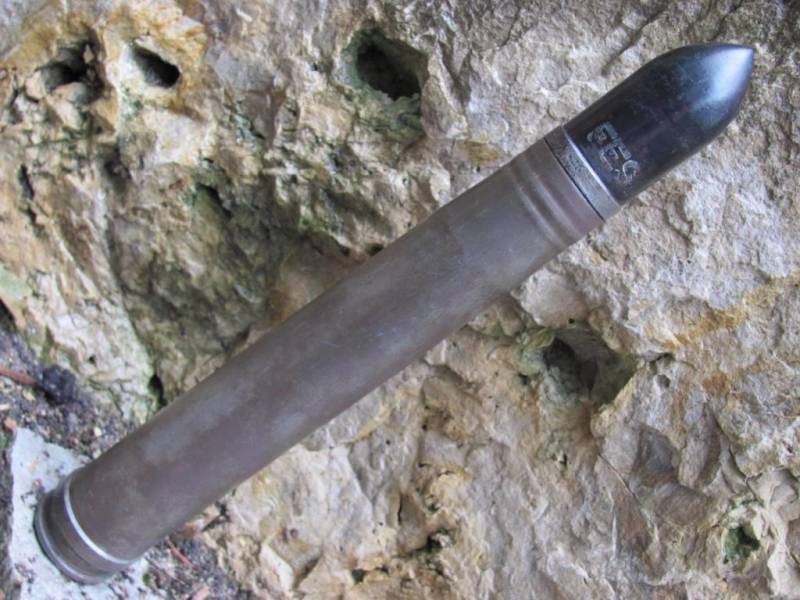
Shot for a 37 mm German automatic anti-aircraft gun
An armor-piercing tracer projectile weighing 680 g in a barrel 2 mm long accelerated to 106 m/s. The thickness of the armor penetrated by an armor-piercing tracer projectile at a distance of 800 m at an angle of 800° was 60 mm. The ammunition of anti-aircraft guns also included shots with fragmentation-tracer, fragmentation-incendiary and fragmentation-incendiary-tracer grenades, and an armor-piercing high-explosive projectile. A sub-caliber armor-piercing tracer projectile weighing 25 g with a carbide core and an initial speed of 405 m/s could be used against armored vehicles. At a distance of 1 m normal, it penetrated 140 mm armor. But, due to the chronic shortage of tungsten, 600-mm sub-caliber projectiles were not used often.
From the very beginning, the 37-mm anti-aircraft gun 3,7 cm Flak 18, created by specialists from the Rheinmetall Borsig AG concern in 1929 and officially put into service in 1935, was considered as a dual-purpose artillery system that, in addition to firing at quickly moving air targets, could fight armored vehicles and manpower.
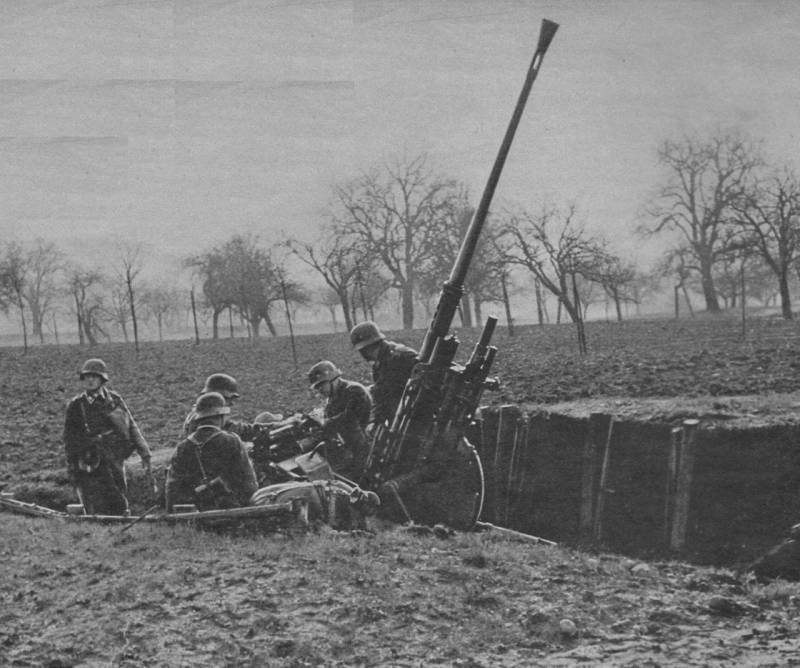
3,7 cm Flak 18 in firing position
The 3,7 cm Flak 18 automatic operated using recoil energy with a short barrel stroke. The shooting was carried out from a pedestal carriage, supported by a cross-shaped base on the ground. In the traveling position, the gun was transported on a four-wheeled cart. The weight of the gun in the combat position was 1 kg, in the stowed position - 760 kg. Calculation – 3 people. Vertical guidance angles: –560° to +7°. In the horizontal plane there was the possibility of all-round firing. Two-speed guidance drives. The maximum firing range at air targets is 7 m. Power was supplied from 80-round clips on the left side of the receiver. Rate of fire – up to 4200 rounds/min. Transportation speed – up to 6 km/h.
In general, the 3,7 cm Flak 18 anti-aircraft gun was quite effective and reliable. It could fire effectively at high-speed air targets at a distance of up to 2000 m, and successfully operate against lightly armored ground targets and manpower within line of sight. Despite the fact that by the beginning of World War II this 37-mm anti-aircraft gun was replaced in production by more advanced models, its operation continued until the end of hostilities.
After combat testing of the 3,7 cm Flak 18 in Spain, German anti-aircraft gunners announced the need to switch from a four-wheeled heavy “cart” to a two-axle vehicle, which was supposed to improve mobility and reduce deployment time to a position. In this regard, in 1936, using the 3,7 cm Flak 18 artillery unit and a new carriage, the 3,7 cm Flak 36 anti-aircraft gun was created.
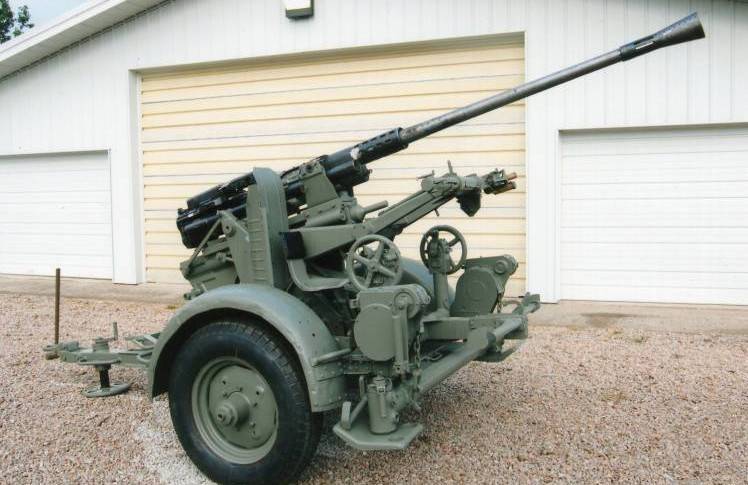
3,7 cm Flak 36 in the stowed position
The weight of the modernized 37-mm anti-aircraft gun in the combat position was reduced to 1 kg, and in the stowed position - to 550 kg. While maintaining the ballistic characteristics and rate of fire of the previous modification, the vertical aiming angles were increased from –2 to +400°.
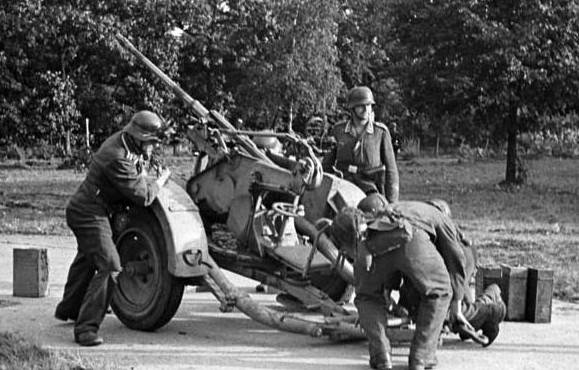
The transition time from traveling to combat position and back has been significantly reduced. The carriage with four supports was removed using a chain winch and placed on a single-axle cart in three minutes. Highway towing speed increased to 60 km/h.
The successes of German specialists in the field of creating mechanical ballistic computers made it possible to begin producing Sonderhänger 52 anti-aircraft sights with a counting device. The fire control of the anti-aircraft battery was carried out using a Flakvisier 40 rangefinder. Thanks to these innovations, the accuracy of fire at distances close to the maximum increased by about a third. In addition, during the production of the 3,7 cm Flak 37 guns, more stamped parts were used, thereby reducing production costs. Otherwise, the 3,7 cm Flak 36 and 3,7 cm Flak 37 guns had the same characteristics.
During the fighting, due to the increase in the flight speed of combat aircraft, German anti-aircraft gunners were faced with the fact that the rate of fire of single 37-mm anti-aircraft guns was not always sufficient to reliably hit a target.
In 1943, the Rheinmetall Borsig AG concern proposed a 37-mm towed anti-aircraft gun, the 3,7 cm Flak 43, with an increased rate of fire. To increase the rate of fire, the automatic operation scheme of the artillery unit has undergone significant revision. The short stroke of the barrel during recoil was combined with a gas release mechanism that unlocks the bolt. The increased shock loads were compensated by the introduction of a spring-hydraulic damper.
Due to all this, it was possible to significantly reduce the time required to perform the operations necessary to fire a shot, and the rate of fire increased to 250–270 rounds/min, which slightly exceeded the rate of fire of the 20-mm 2,0 cm FlaK 30 assault rifle. The combat rate of fire was 130 rds/min. Weight in combat position - 1 kg, in stowed position - 250 kg. The vertical pointing angle of the barrel was increased to 2°. To increase the practical rate of fire and the length of a continuous burst, the number of shots in the clip was increased to 000 units. The barrel length, ammunition and ballistics of the Flak 90 remained unchanged compared to the Flak 8.
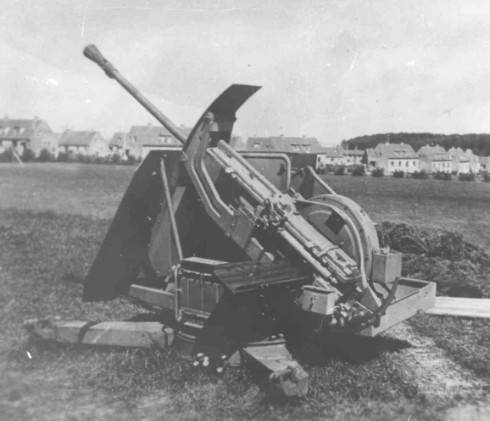
3,7 сm Flak 43
The gun was transported on a single-axle sprung trailer, with pneumatic and hand brakes, as well as a winch for lowering and raising the gun when transferring it from the traveling position to the combat position and back. The frames had jacks for leveling the anti-aircraft gun. The lifting mechanism is sectoral, with one aiming speed. The rotary mechanism had two aiming speeds. The balancing of the swinging part was carried out by a balancing mechanism with a spiral spring. Taking into account the experience of combat operations, the 3,7 cm Flak 43 installation was equipped with a steel shield with two folding side flaps, which reduced the vulnerability of the crew when repelling air attacks and shelling from the ground.
In addition to increasing the combat rate of fire, specialists from the Rheinmetall Borsig AG concern have done a lot of work to improve the manufacturability of production, for which they increased the share of stamped parts. This made it possible to quickly establish production and reduce the cost of the new 37-mm anti-aircraft gun. In July 1944, 180 machine guns were delivered, in December - 450 guns. In March 1945, 1 032 cm Flak 3,7 guns were in service.
Simultaneously with the single-barreled 3,7 cm Flak 43 gun, a twin Flakzwilling 43 installation was created. The artillery machine guns in it were located one above the other, and the cradles on which the machine guns were mounted were connected to each other by a rod forming a parallelogram joint. Each gun was located in its own cradle and formed a swinging part, rotating relative to its annular axles.
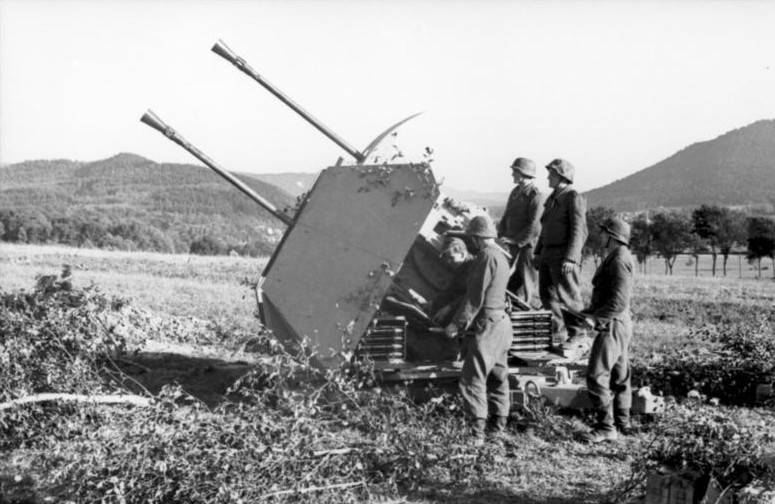
Anti-aircraft gun ]Flakzwilling 43 at the firing position
The vertical arrangement of the barrels created difficulties during clip loading and increased the height, but at the same time the shooting accuracy improved, since there was no dynamic torque in the horizontal plane that would disrupt aiming. The presence of individual trunnions for each machine gun minimized disturbances affecting the swinging part of the anti-aircraft gun, and made it possible to use the artillery unit from single mounts without any modifications. In the event of failure of one gun, it was possible to fire from the second without disrupting the normal aiming process. The weight of the twin 37-mm installation has increased by about 43% compared to the Flak 40, and the combat rate of fire has almost doubled.
Until March 1945, the German industry produced 5 918-mm Flak 37 anti-aircraft guns, and 43 Flakzwilling 1 twins. Despite the higher level of combat performance, the Flak 187 was not able to completely displace the Flak 43/43 from the production lines of 36-mm anti-aircraft guns 37 cm Flak 37/3,7, of which more than 36 units were produced.
In the Wehrmacht, towed 37-mm anti-aircraft guns were reduced to batteries of 9 guns. The anti-aircraft battery of the Luftwaffe, placed in stationary positions, could have up to 12 37-mm cannons.
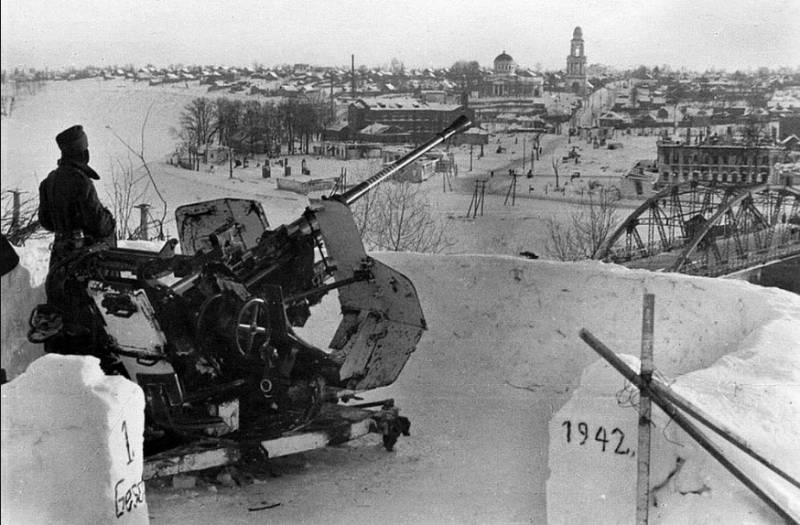
In addition to being used in a towed version, the 3,7 cm Flak 18 and Flak 36 anti-aircraft guns were installed on railway platforms, various trucks, half-track tractors, armored personnel carriers and tank chassis.
At the final stage of the war, in conditions of an acute shortage of anti-tank weapons, a significant part of the German 37-mm anti-aircraft guns were used to fire at ground targets. Due to low mobility, automatic anti-aircraft guns were used mainly in pre-equipped positions in defense centers. Thanks to good armor penetration for their caliber and high rate of fire, they posed a certain danger to medium Soviet tanks and, when firing fragmentation shells, could successfully repel infantry attacks.
During the war, the Red Army captured a significant number of German-made 37 mm machine guns. However, in contrast to the captured 20-mm anti-aircraft guns, which were quite widely used in the Red Army, information on the use of 37-mm guns for their intended purpose could not be found, which, apparently, is explained by the shortage of German 37-mm shells, ignorance of the material part and lack of training of the Red Army soldiers how to use German POISOs. It is known that until the end of 1943, Soviet troops made limited use of captured 3,7 cm Flak 18/36/37 anti-aircraft guns in defense centers against enemy armored vehicles and infantry.
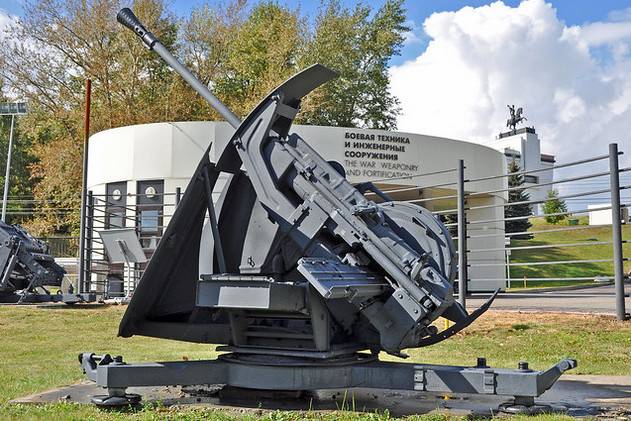
Soviet experts in the field of anti-aircraft weapons carefully studied the German 37-mm anti-aircraft guns, which received a positive assessment in terms of sights, fire control devices, workmanship, design solutions and production technology. All this was subsequently taken into account when developing domestic anti-aircraft guns in the post-war period.
German anti-aircraft 37-mm automatic guns were actively used by the armed forces of countries allied with Nazi Germany; they were supplied to Bulgaria, Hungary, Spain and Finland. The 3,7 cm Flak 36 guns were produced in Romania under the designation Tun antiaerian Rheinmetall calibru 37 mm model 1939. A significant number of 37 mm anti-aircraft guns were captured by the Americans and British during the liberation of France, Norway, Belgium and the Netherlands from the Nazis.
After the end of World War II, towed 37-mm German anti-aircraft guns remained in service in Bulgaria, Czechoslovakia and Norway for about 10 more years. German 37-mm anti-aircraft guns had fairly high combat and service-operational characteristics, but for objective reasons in the first post-war decade they were almost completely replaced by anti-aircraft guns used in the victorious countries: 40-mm Bofors L60 and 37-mm 61-K.
In Francoist Spain, active use of the 3,7 cm Flak 18 and 3,7 cm Flak 36 continued until the end of the 1960s. The 3,7 cm Flak 36 was in service the longest in Romania. They served in this country for approximately two post-war decades. In the early 1960s, these guns were transferred to warehouses. Three dozen 37-mm German-style anti-aircraft guns were in storage until the early 1980s.
Naval 37 mm anti-aircraft guns
In the initial period of World War II, the anti-aircraft units of the Wehrmacht and Luftwaffe were armed with 37-mm anti-aircraft guns, which in their characteristics fully met the requirements for guns of this type. Although there was always a shortage of anti-aircraft rapid-firing artillery in the front-line zone, the German command of the ground forces could not claim that their 37-mm anti-aircraft guns were inferior to those available in the USSR, USA or Great Britain.
A different situation arose in the Kriegsmarine. Deck-mounted 37-mm anti-aircraft guns, which used semi-automatic 3,7 cm SK C/30 guns, had the best direct shot range of their caliber and very high accuracy, but in terms of practical rate of fire they were several times inferior to army machine guns of the same caliber. In addition, manual dispensing of one cartridge at a time compared to automatic installations required a larger number of people involved in the process of loading and carrying ammunition, which was very critical when placing semi-automatic weapons on the decks of small-displacement ships, boats and submarines.
Having suffered with the 3,7 cm SK C/30 semi-automatic guns in the initial period of the war, the German admirals quite naturally came to the conclusion that it was necessary to replace them as soon as possible with automatic 37 mm guns, adapted for use in navy.
Based on the existing developments on land anti-aircraft guns, the Rheinmetall Borsig AG concern in the late 1930s created the 3,7 cm Flak C/36 deck anti-aircraft gun, which used a 37x248R round with three types of shells: armor-piercing tracer, fragmentation tracer, fragmentation-incendiary-tracer.

37mm cartridge 37×248R with fragmentation tracer
Although the cartridge case of this cartridge was somewhat shorter than that of the “land” 37-mm ammunition, it fully met the requirements in terms of power. The fragmentation tracer projectile weighing 0,635 g had an initial speed of 845 m/s and contained 26 g of TNT. At the end of the war, shells of this type began to be equipped with an alloy of TNT and hexogen, containing about 15% aluminum powder, to increase the high-explosive and incendiary effect.
In 1942, the modified 3,7 cm Flak C/36 automatic cannon underwent a set of necessary modifications and tests. The adoption of the 37-mm naval assault rifle took place in 1943, and it received the designation 3,7 cm Flak M42 (the name 3,7 cm M/42 is also found). The machine gun, with parts made from corrosion-resistant steels and intended primarily for placement on submarines, is known as the 3,7 cm Flak M42U. First of all, the new 37-mm automatic anti-aircraft guns were sent to Type VII-C submarines. At the beginning of 1944, M/42 guns began arriving on surface ships. As part of the Barbara program, adopted to strengthen the air defense of the German fleet with single-barreled and twin M/42 assault rifles, it was planned to replace most of the 37-mm semi-automatic guns.
For installation on the deck, the 37-mm artillery unit was placed on a pedestal, providing all-round fire. The first serial installation with the 3.7 cm Flak M42 assault rifle was the single-barrel Ubts. LC/39, designed for submarines, which was created using the pedestal base of a single-barrel 37-mm semi-automatic SK C/30. Following the installation of Ubts. The LC/39 was followed by the single-barrel Flak LM/42, intended for placement on surface ships.
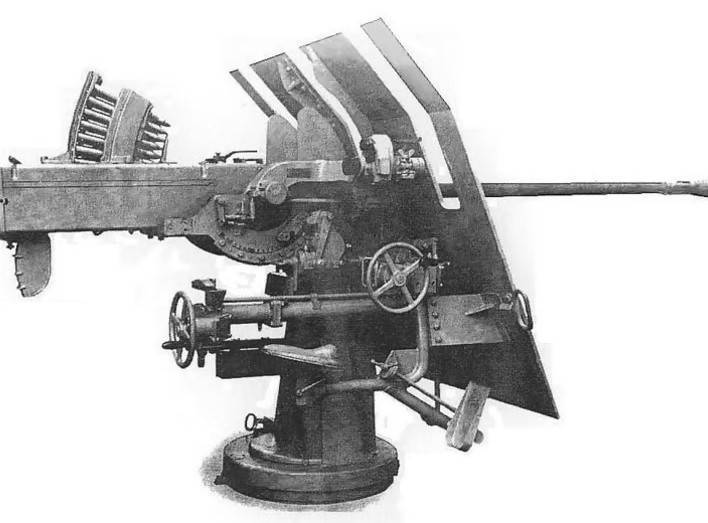
37-mm Flak LM/42 anti-aircraft gun
The weight of the installation, depending on the version, was 1–320 kg. Vertical aiming range: –1° to +370°. Compared to a land anti-aircraft gun of the same caliber, the barrel length increased from 10 to 90 calibers (from 57 mm to 69 mm) and the rifling pitch changed. The rate of fire reached 2 rounds/min, the practical rate of fire was half that. The height reach at an elevation angle of 112° was 2 m. The effective firing range at air targets was up to 560 m.
Unlike German land-based 37-mm machine guns, which were loaded with a clip from the side, naval anti-aircraft guns were loaded with a clip from the top. The calculation of the deck installation was 4–6 people. When repelling enemy air raids, other crew members were brought in to carry ammunition. Partial protection of the crew from bullets and shrapnel in the frontal projection was provided by a steel shield 8 mm thick. The shields of anti-aircraft guns on submarines had hinges, which allowed them to be folded to reduce drag when the submarine was underwater. In addition, the sights of installations on submarines were sealed. The shields of the installations of surface ships had a more complex shape and did not fold.
Soon after the adoption of the single-barrel 37-mm anti-aircraft gun Flak LM/42 into service, twins were launched into production: Ubts. Dop. LM/42 – for submarines and Dop. LM/42 - for surface ships.
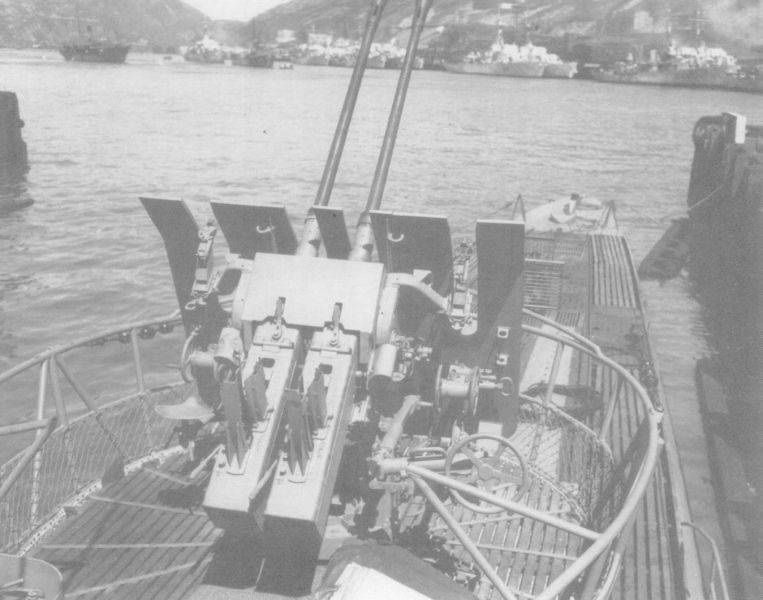
Twin installation Ubts. Dop. LM/42 on a submarine
Single-barreled and coaxial 37-mm anti-aircraft guns had a significant advantage over the semi-automatic 3,7 cm SK C/30 guns and, in the case of complete rearmament, the German anti-aircraft defense of the near zone could be significantly strengthened. The new destroyers were supposed to have fourteen 37-mm guns, on destroyers - up to 6 guns, on minesweepers it was planned to have 1-2 guns, on submarines 37-mm single-barrel or twin guns were supposed to replace semi-automatic guns of the same caliber.
However, time was largely lost, and the industry of the Third Reich, overloaded with military orders, was unable to adequately saturate the fleet with 37-mm machine guns. The program for rearmament of surface ships was fully implemented only on a few destroyers and destroyers, and many ships were equipped with what was currently available. However, some submarines received 37-mm automatic guns in addition to what was originally provided for by the project.
According to plans approved at Potsdam in July 1945, the surviving Kriegsmarine ships were to be divided among the Allies. In order to avoid disputes about who would get specific ships, their future fate was determined by drawing lots. During the division of the German fleet, the Soviet Union accounted for 155 warships and 499 auxiliary vessels. Including: the light cruiser Nuremberg, 10 destroyers and destroyers, a large patrol ship, 43 specially built minesweepers and ten submarines.
The warships introduced into the USSR Navy partially retained German weapons. For example, the air defense of the destroyer Z-33 type 1936A (Mob), which received the name “Agile” in 1946, was provided by fourteen 37-mm Flak LM/42 and Dop guns. LM/42. Some captured minesweepers and high-speed landing barges were also equipped with automatic 37-mm anti-aircraft guns.
However, German anti-aircraft guns were retained only on surface ships; they were removed from German submarines introduced into the Soviet fleet. In 1946, Great Britain transferred to France several destroyers that were inherited during the division of the German fleet, which also had 37-mm machine guns.
In the Soviet Navy, the last captured destroyers were decommissioned in the second half of the 1950s; some German-built minesweepers were in service until the early 1960s.
The service of German destroyers in the French Navy was also short-lived; all of them were scrapped for metal in the late 1950s.
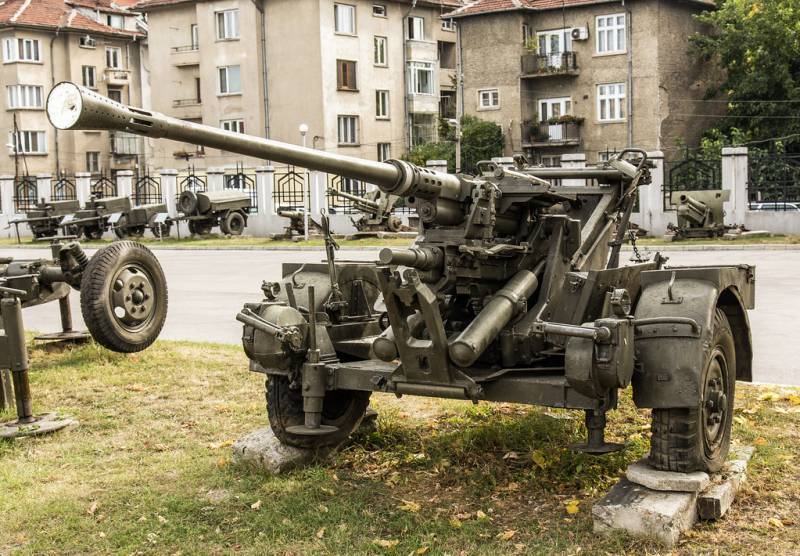
Information